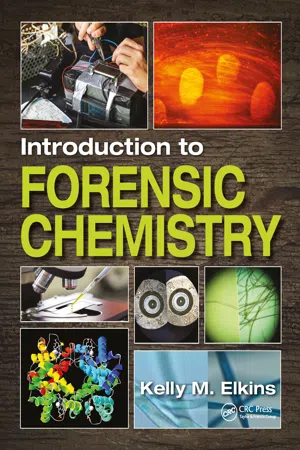
- 324 pages
- English
- ePUB (mobile friendly)
- Available on iOS & Android
Introduction to Forensic Chemistry
About this book
Chemistry/Forensic Science
Forensic chemistry is a subdiscipline of forensic science, its principles guide the analyses performed in modern forensic laboratories. Forensic chemistry's roots lie in medico-legal investigation, toxicology and microscopy and have since led the development of modern forensic analytic techniques and practices for use in a variety of applications.
Introduction to Forensic Chemistry is the perfect balance of testing methods and application. Unlike other competing books on the market, coverage is neither too simplistic, nor overly advanced making the book ideal for use in both undergraduate and graduate courses. The book introduces chemical tests, spectroscopy, advanced spectroscopy, and chromatography to students. The second half of the book addresses applications and methods to analyze and interpret controlled substances, trace evidence, questioned documents, firearms, explosives, environmental contaminants, toxins, and other topics. The book looks at innovations in the field over time including the latest development of new discernible chemical reactions, instrumental tools, methods, and more.
Key features:
- Nearly 300 full-color figures illustrating key concepts and over 20 case studies
- Addresses all the essential topics without extraneous or overly advanced coverage
- Includes full pedagogy of chapter objectives, key terms, lab problems, end of chapter questions, and additional readings to emphasize key learning points
- Includes chemical structures and useful spectra as examples
- Fulfils the forensic chemistry course requirement in FEPAC-accredited programs
- Includes a chapter on Chemical, Biological, Radiological, Nuclear, and Explosive (CBRNE) materials
Comprehensive and accessible, without being overly technical, Introduction to Forensic Chemistry will be a welcome addition to the field and an ideal text designed for both the student user and professor in mind.
Course ancillaries including an Instructor's Manual with Test Bank and chapter PowerPoint® lecture slides are available with qualified course adoption.
Frequently asked questions
- Essential is ideal for learners and professionals who enjoy exploring a wide range of subjects. Access the Essential Library with 800,000+ trusted titles and best-sellers across business, personal growth, and the humanities. Includes unlimited reading time and Standard Read Aloud voice.
- Complete: Perfect for advanced learners and researchers needing full, unrestricted access. Unlock 1.4M+ books across hundreds of subjects, including academic and specialized titles. The Complete Plan also includes advanced features like Premium Read Aloud and Research Assistant.
Please note we cannot support devices running on iOS 13 and Android 7 or earlier. Learn more about using the app.
Information
Table of contents
- Cover
- Half-Title
- Title
- Copyright
- dedication
- Contents
- List of Figures
- List of Tables
- Acknowledgements
- Author
- List of abbreviations
- 1 An introduction to forensic chemistry and physical evidence
- 2 Chemical tests
- 3 The microscope
- 4 Light spectroscopy
- 5 Advanced spectroscopy
- 6 Chromatography
- 7 Inorganic poisons and contaminants
- 8 Controlled substances
- 9 Toxicology
- 10 Trace evidence
- 11 Questioned documents and impression evidence
- 12 Latent print development
- 13 Firearms
- 14 Fire, arson, and explosives
- 15 Chemical, biological, radiological, nuclear, and explosives (CBRNE)
- 16 Environmental forensics
- Index